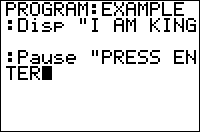TI-BASIC:Pause
Command Summary
Pauses the program until the user presses ENTER.
Command Syntax
Pause [value-or-text]
Menu Location
While editing a program, press:
- PRGM to enter the PRGM menu
- 8 to choose Pause, or use arrows
TI-83/84/+/SE
1 byte
The Pause command is used for suspending the execution of a program at a certain point. This is useful when you have text or instructions on the home screen that you want the user to read before the program continues on to the next thing. While the program is paused, the pause indicator turns on in the top-right corner of the screen (it is the dotted line that moves around).
After the user is done reading the text or instructions, they must press ENTER to resume program execution. One place the Pause command is commonly used is right before clearing the screen with ClrHome, because otherwise the text on the screen will show up for a split second before it is erased. The Pause command gives the user ample time to look at and read the text.
:Pause
An alternative to the Pause command that is commonly used is a Repeat loop with a GetKey command as the condition. This is sometimes more appropriate in a program if you don't want to bring the program to a complete standstill, and you want the user to be able to resume program execution with any key instead of just ENTER (see Usability for more information).
:Repeat getKey :End
Advanced Uses
The Pause command has an optional argument that can either be text, a number, a variable, or an expression. This argument will be displayed on the next available blank line on the home screen while the program is paused, and it can be scrolled if it is larger than the screen. Although the Pause command can be used with the graph screen, the argument will still be displayed on the home screen.
Caution: Unlike any other text command, or indeed any other command at all, this optional argument will be stored to Ans after the pause! This could be used to your advantage, but most of the time, it's a nuisance, and if you use Ans for optimization, watch out for this side effect.
Displaying text with the Pause command follows the same pattern as the Disp command, so text is displayed on the left and everything else is displayed on the right. It also means that if there is already text on the seventh row, it will automatically move everything up one row so it can display its text. In addition, the Pause command is affected by the Output( command and its text.
PROGRAM:PAUSE :ClrHome :"World! :Disp " Hello "+Ans :Output(2,2,"Goodbye :Pause Ans
When the calculator is paused, it is possible for another linked calculator to use the GetCalc( command to transfer a variable.
Optimization
When you have a Disp command before a Pause command, you can take the text or variable from the Disp command and place it after the Pause command as its optional argument. This allows you to remove the Disp command. If the Disp command has multiple arguments, you just take the last one off and put it as the optional argument.
:Disp A :Pause can be :Pause A
When using the optional argument of Pause, it is stored to Ans, and this can in rare cases be used for optimization. The most common one would probably be using Pause to show work for a calculation, as in the following program:
:Disp "A+B= :Pause A+B :Disp "(A+B)²= :Pause Ans² :Disp "(A+B)²-C²= :Pause Ans-C²
Error Conditions
- ERR:INVALID occurs if this statement is used outside a program.
